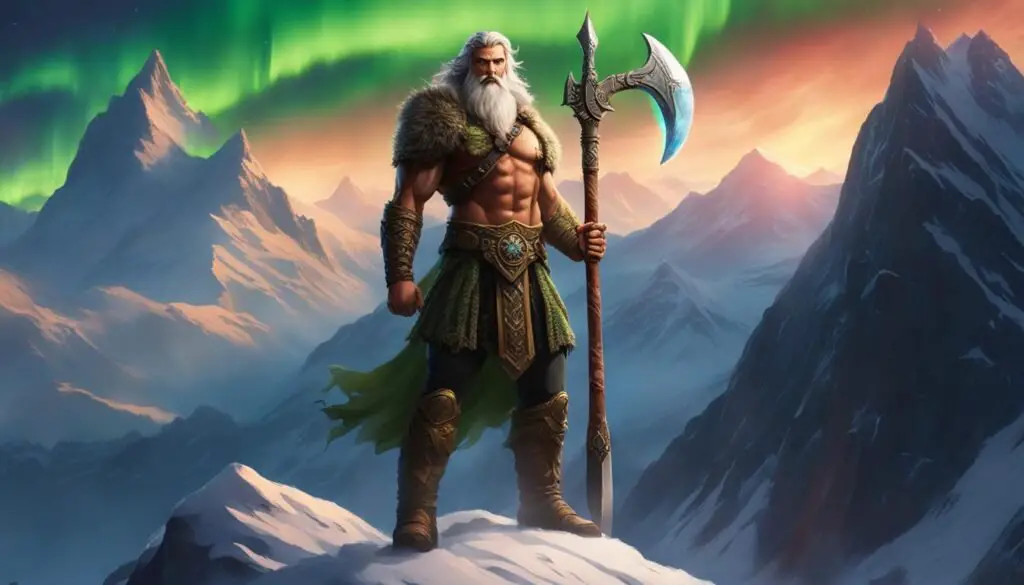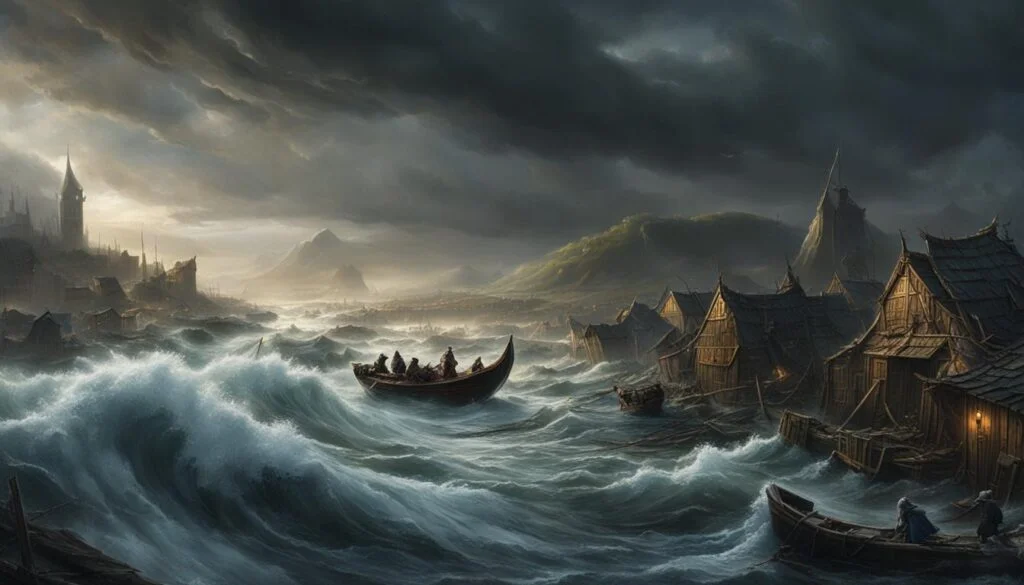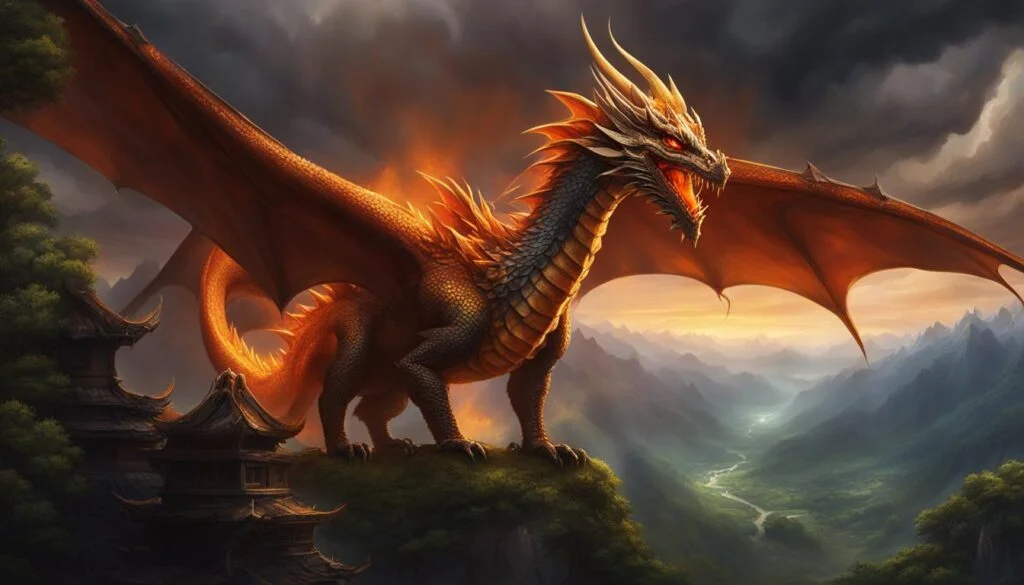In Norse mythology, the realm of gods and mortals intertwines, giving rise to powerful and fascinating beings known as demigods. These Norse demigods, born from the union of gods and mortals, possess extraordinary abilities that set them apart from both humans and gods alone.
Within Norse mythology, demigods play a significant role as exceptional warriors, heroes, and protectors of humanity. With their unique lineage, they are revered for their strength, bravery, and unwavering devotion to their purpose.
Key Takeaways:
- Norse demigods are half-human, half-divine beings born from the union of gods and mortals.
- They possess extraordinary powers and are exceptional warriors, heroes, and protectors of humanity.
- Thor and Loki are among the most powerful Norse demigods, known for their strength and cunning.
- Norse goddesses, born from the union of gods and mortal women, are also revered as demigods.
- Demigods in Norse mythology add depth and complexity to the stories of gods and mortals, making the mythology captivating and enduring.
Norse Mythology: The Role of Demigods
In Norse mythology, demigods play a multifaceted and significant role. These extraordinary beings, born from the union of gods and mortals, possess exceptional powers due to their divine heritage. They are revered as exceptional warriors and heroes, wielding their strength and prowess in battles against giants and other formidable creatures.
Demigods are not only protectors of humanity but also important contributors to the creation of the world and the captivating stories of gods and mortals in Norse mythology. Their presence in the Norse pantheon adds depth and complexity to the rich tapestry of characters and deities that inhabit this ancient mythological universe.
Throughout Norse mythology, the demigods’ valor and heroism shine through their actions, forging their place as revered figures in the Norse pantheon. They embody the strength, resilience, and legendary essence of Norse culture and folklore.
Powerful Norse Demigods
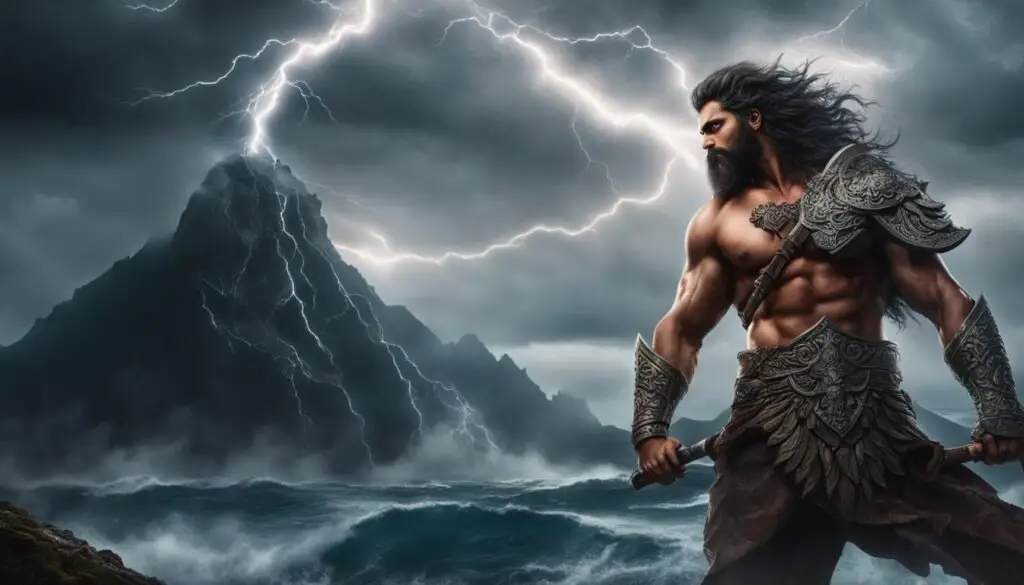
When it comes to the most powerful demigods in Norse mythology, two names stand out: Thor and Loki.
Thor, the son of Odin and the giantess Jord, is known as the god of thunder. With his powerful hammer, Mjolnir, Thor possessed immense strength and was a formidable warrior. He fearlessly battled giants, trolls, and monsters, epitomizing bravery and valor. Thor’s hammer, Mjolnir, was instrumental in his victories, making him one of the most feared and respected demigods in Norse mythology.
Loki, on the other hand, was a complex character. The son of the giant Farbauti and the goddess Laufey, Loki possessed a cunning mind and a mischievous spirit. Often seen as the god of chaos and trickery, Loki’s actions caused both strife and unexpected resolutions. While Loki’s motives were not always noble, he proved to be a valuable ally to the gods in their battles against their enemies. Despite his questionable allegiance, Loki’s intelligence and resourcefulness made him an influential and powerful demigod in Norse mythology.
These two demigods, Thor and Loki, represent the duality of power and complexity within Norse mythology. While Thor embodies strength and valor, Loki showcases the cunning and unpredictability that define the demigods of this ancient pantheon.
Norse Gods and Mortal Offspring

In Norse mythology, the gods were not only powerful beings who ruled over the realms but also had mortal children who inherited their divine qualities. These mortal offspring, considered demigods in Norse mythology, played significant roles in the intricate stories of the gods and mortals.
One famous example of a mortal offspring is Thor, the son of Odin, the chief god, and the giantess Jord. Thor possessed incredible strength and was known as the god of thunder. He wielded the mighty hammer, Mjolnir, and was a formidable warrior who fought against giants, trolls, and other monstrous creatures.
Another notable demigod is Heimdall, the watchman of the gods and son of nine mothers, who were either nine sisters or nine giantesses. Heimdall possessed exceptional senses and could perceive the slightest sounds and observe far distances. He is often described as the guardian of the Bifrost, the rainbow bridge connecting Asgard, the realm of the gods, and Midgard, the realm of humans.
These mortal offspring of the Norse gods showcased extraordinary abilities and played crucial roles in the mythology. They exemplify the intricate relationships between deities and humans, bridging the realms of divinity and mortality.
Norse Goddesses: The Female Demigods
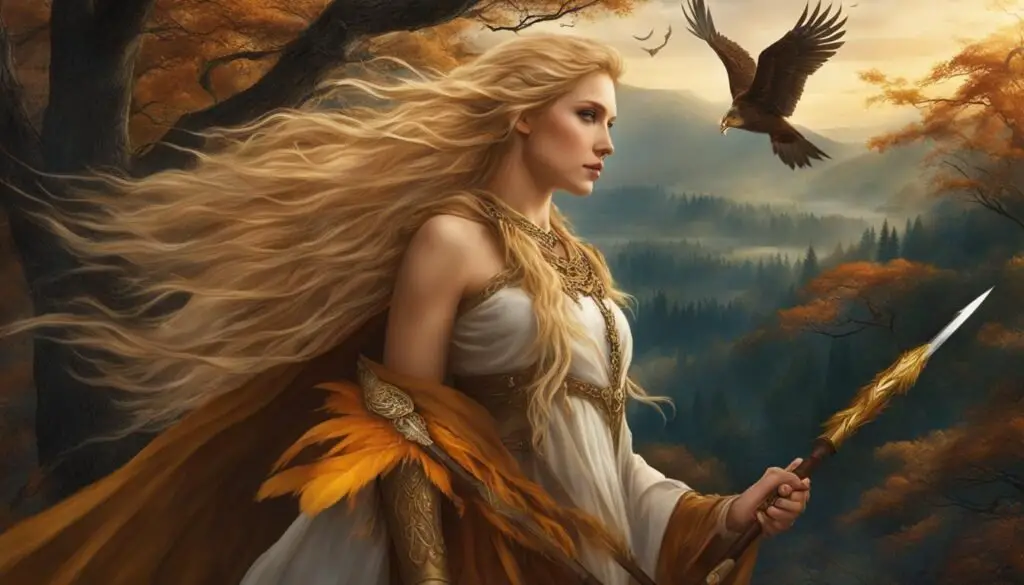
Norse mythology is not only populated by powerful gods and heroic demigods, but also by awe-inspiring goddesses who hold their own as formidable figures. Born from the union of gods and mortal women, these female demigods, known as Norse goddesses, are revered for their beauty, wisdom, and immense power.
One prominent Norse goddess is Freyja, the goddess of love and fertility. With her enchanting allure and magical abilities, she captivated both gods and mortals alike. Known for her association with desire, pleasure, and sensuality, Freyja played an essential role in the realm of relationships and procreation.
Another notable Norse goddess is Skadi, the goddess of winter and the hunt. Skadi personified the strength and perseverance required to survive the harsh Nordic winters. As a skilled huntress and an expert in archery, she embodied the fierce and independent spirit of the wilderness.
These Norse goddesses, with their distinct qualities and domains, contributed to the intricate tapestry of Norse mythology. Their stories were interwoven with those of the gods and mortals, shaping the narrative and enriching the cultural heritage of the Norse people.
Valkyries: Divine Beings, not Demigods
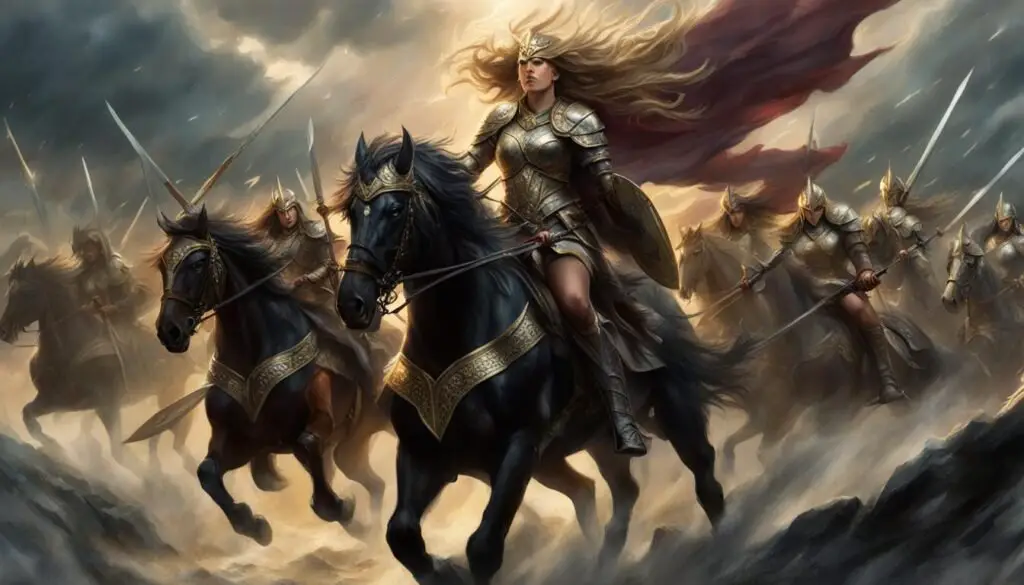
The Valkyries hold a prominent position in Norse mythology as powerful and revered figures. Contrary to popular belief, they are not demigods but rather divine beings chosen by Odin, the king of the gods, to serve a crucial role. As Valkyries in Norse mythology, their primary responsibility is to select the worthy warriors who have fallen in battle, guiding them to their final destination: Valhalla, the renowned hall of the slain.
The Valkyries are depicted as fierce and strikingly beautiful, embodying an ethereal grace that captures the imagination. They are associated with essential aspects of human existence, such as death, destiny, and fate. The Valkyries’ role extends beyond mere selection; they also weave the threads of destiny, influencing the outcome of battles and shaping the lives of mortals according to the gods’ intricate designs.
Visualize the majestic Valkyries, their flowing hair catching the wind as they ride through the sky on magnificent horses, ready to carry out their divine duties. As divine beings, their presence invokes awe and inspires courage in the hearts of warriors. An image that captures this ethereal essence is shown below:
Valkyries in Mythology: Key Attributes and Abilities
Let’s delve deeper into the characteristics and abilities attributed to the Valkyries:
- The Valkyries possess exceptional strength, skill, and prowess in battle, reflecting their divine nature.
- They ride spectral horses, which can traverse both land and sky, allowing them to carry out their tasks swiftly.
- Through their ability to navigate the realms of the gods and mortals, Valkyries act as conduits, connecting the divine and earthly realms.
- The Valkyries have the power to heal and revive fallen warriors, enabling them to continue fighting, even in the face of death.
- These divine beings also possess foresight, being able to see into the future and predict the outcomes of battles and conflicts.
The distinction between Valkyries and demigods is vital to understanding the rich tapestry of Norse mythology. While demigods bear the bloodline of both gods and mortals, the Valkyries belong to a distinct realm of divinity, serving Odin and the higher purposes of the gods. Their place in the mythology showcases the intricate layers within this ancient belief system, capturing the imagination and inspiring countless tales of valor and fate.
Dark Norse Gods: Exploring Hel and Odin
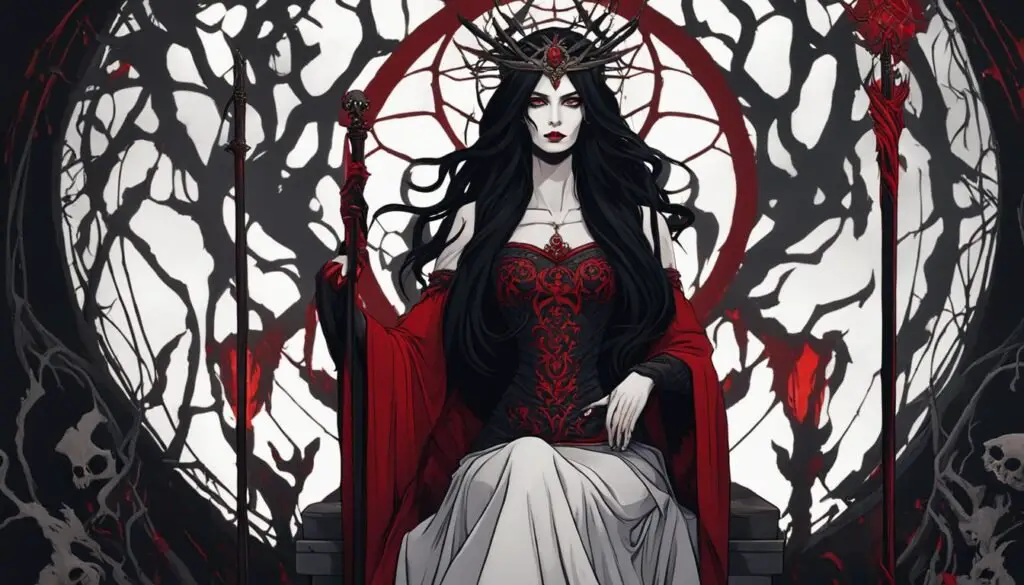
In Norse mythology, there were gods associated with darkness and death. These gods played important roles in the mythology and symbolism of Norse culture.
Hel in Norse Mythology:
Hel, the daughter of Loki and the giantess Angrboda, ruled over the underworld. She was responsible for receiving the souls of the dead. Hel’s realm, also known as Helheim, was a place of darkness and cold where the souls of those who did not die in battle resided. Hel was a formidable and mysterious figure, embodying the somber aspects of the Norse pantheon.
Odin in Norse Mythology:
Odin, the king of the gods, was also associated with darkness and death. Often depicted as a one-eyed figure with a cloak shrouding him, Odin embodied the archetype of the wise old man and the bringer of death. He was known as the god of war, fate, and wisdom. Odin’s connection to darkness and death was closely tied to his quest for knowledge and his role as the chooser of the slain in battle.
These dark Norse gods added depth and complexity to the pantheon, reflecting the dualistic nature of the cosmos in Norse mythology. Their stories and symbolism continue to captivate readers and provide insight into the beliefs and values of ancient Norse culture.
Other Mythologies and Demigods
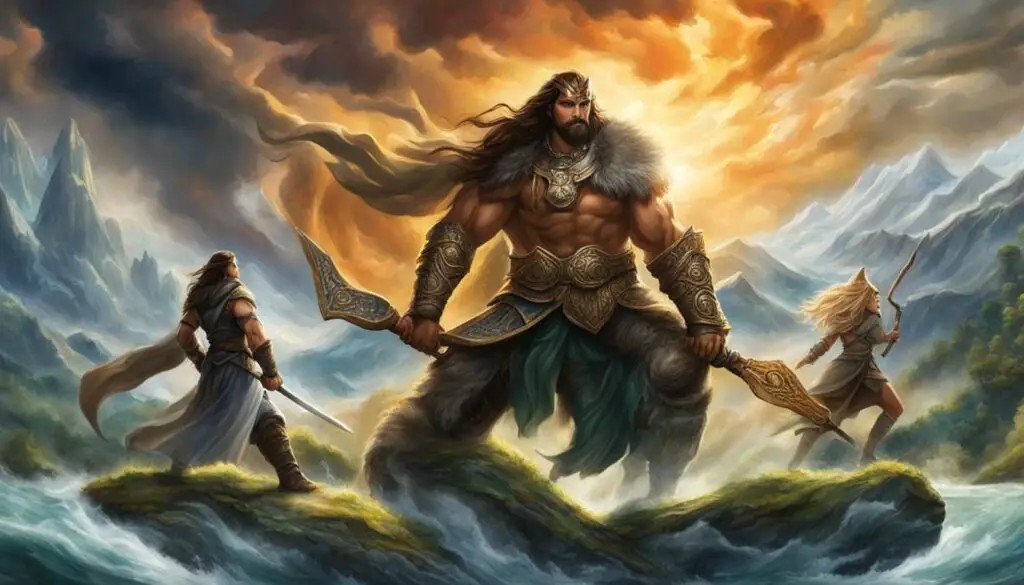
Demigods are not exclusive to Norse mythology; they exist in various mythologies worldwide. Greek and Roman mythology, for example, are renowned for their demigods, such as Hercules and Achilles. These half-human, half-divine beings possessed exceptional powers and played significant roles in the mythological narratives. Hindu mythology also features demigods known as “Devas,” who start as demigods and eventually ascend to become full-fledged gods.
While the concept of demigods is present in multiple mythologies, they differ in their characteristics and roles. In Norse mythology, demigods like Thor and Loki were known for their warrior prowess and played vital roles in protecting humanity and aiding the gods. In comparison, the demigods of Greek mythology, such as Heracles, were renowned for their heroic feats and often embarked on epic quests.
By exploring demigods from different mythologies, we discover a fascinating tapestry of divine genealogy and extraordinary abilities. Each mythology brings its unique flavor and perspective to the demigod archetype, enriching the overall narrative and cultural significance.
Demigods in Greek Mythology
- Hercules: Known for his immense strength and twelve labors.
- Achilles: Famed for his invulnerability, except for his heel.
- Perseus: The legendary hero who slayed the Gorgon Medusa.
Demigods in Hindu Mythology
- Hanuman: A monkey deity renowned for his incredible strength and devotion.
- Indra: The king of gods and demigods in Hindu mythology.
- Bhima: A mighty warrior with unmatched prowess in battle.
The comparison of demigods in different mythologies provides a fascinating glimpse into the diverse cultural interpretations of these powerful and often legendary beings. Each mythology offers its own unique perspective on the demigod archetype, showcasing the rich tapestry of human imagination and the universality of mythological themes.
Godly Lineages in Norse Mythology
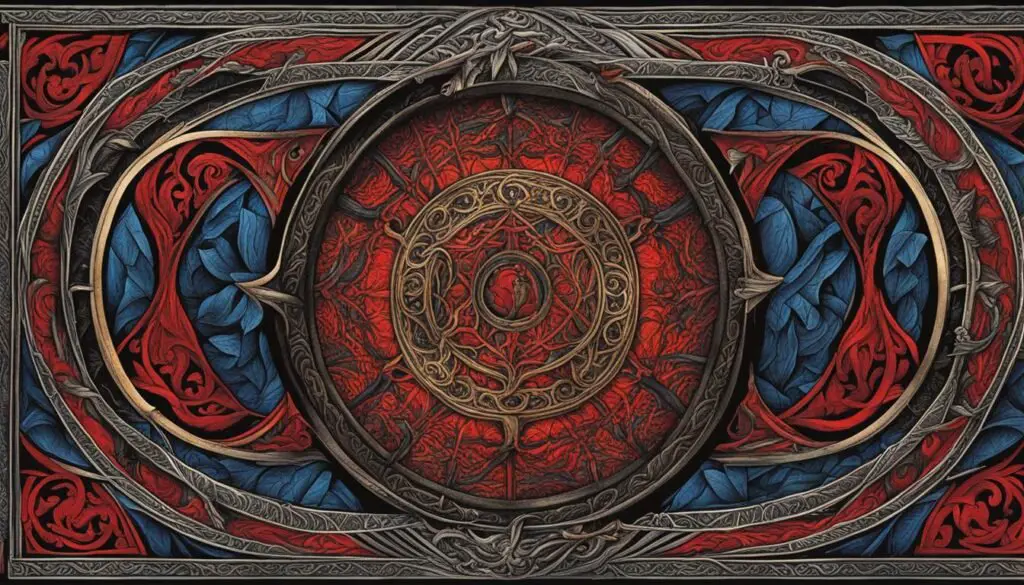
In Norse mythology, the tales of demigods extend beyond individuals and encompass specific groups of people that were believed to be descended from gods, creating what could be referred to as demigod lineages. These lineages, resembling the divine blood flowing through their veins, played significant roles in Norse sagas and legends, weaving themselves into the intricate tapestry of Norse mythology.
- Volsungs: One such group was the Volsungs, who boasted a direct lineage from Odin, the king of the gods. It is believed that Odin himself progenated the Volsung dynasty, blessing them with the divine qualities of courage and strength. The Volsungs were renowned heroes, often finding themselves at the center of epic battles and heroic quests, leaving an indelible mark in the annals of Norse mythology.
- Scyldings: Another notable group claiming heritage from the gods is the Scyldings. They traced their lineage back to Skiold, a son of Odin, and considered themselves the descendants of a divine bloodline. The Scyldings were highly respected in Norse society, with their leaders often serving as powerful kings and rulers. Their exploits are immortalized in numerous sagas, demonstrating the influence and prominence of their demigod heritage.
The existence of these demigod groups further exemplifies the intermingling of divine and mortal realms in Norse mythology. These lineages were not only a testament to the divine ancestry of these groups but also a source of great pride and honor, shaping their destinies and leaving an enduring legacy.
Norse Gods’ Interactions with Humans
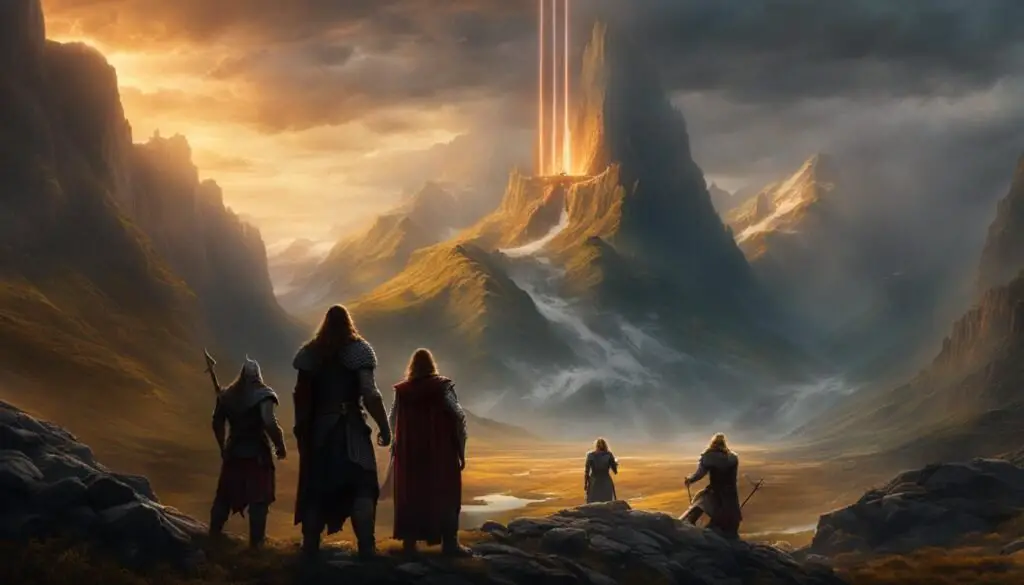
In Norse mythology, the gods were not distant figures, but beings who frequently engaged with humans. They crossed the Bifrost, the bridge connecting Asgard (the realm of the gods) and Midgard (the realm of humans), to visit the mortal realm. These interactions between Norse gods and humans were essential in shaping the mythology and the relationship between the divine and mortal realms.
When the gods descended to Midgard, they didn’t just observe from afar. They actively engaged with humans, talking to them, sharing meals, and even forming complex relationships. The interactions were not limited to grand gestures or battles; they encompassed everyday moments, which highlighted the similarities and differences between gods and humans.
The powerful Norse gods guided and helped humans, serving as protectors and offering their wisdom and expertise. They were generous in sharing their divine knowledge and magic with humans, empowering them to overcome challenges and achieve greatness. The gods also punished humans when necessary, reinforcing the lessons of morality and honoring the divine laws.
These interactions between gods and humans in Norse mythology illustrate the intricate dynamics between the divine and mortal realms. They portray a mythology where gods were not distant deities, but beings who genuinely cared for humanity and often played an active role in mortal affairs. The stories of these interactions provided a sense of connection and meaning, emphasizing the overlap and mutual influence between gods and humans.
The Bridge of Bifrost: A Connection Between Realms
The Bifrost, often depicted as a rainbow bridge, served as a connection between Asgard and Midgard. It enabled the gods to cross over and visit the mortal realm. The Bifrost symbolized the importance of the interactions between the divine and mortal realms, emphasizing the interconnectedness and interdependence of these two worlds.
- The gods’ interactions with humans were essential for Norse mythology, shaping the stories and characters that have captured the imagination for centuries.
- These interactions demonstrate a unique blend of power and humanity, as the gods exhibited both their divine might and their ability to relate to humans on a personal level.
- Through their interactions, the Norse gods showcased the values and virtues they believed humans should embody, encouraging bravery, honor, and wisdom.
Overall, the interactions between Norse gods and humans formed an integral part of Norse mythology. These tales of divine interventions, guidance, and punishment highlight the deep connection between the two realms and provide insights into the complex relationship between gods and mortals in Norse culture.
Conclusion
Norse mythology is a captivating realm filled with a diverse array of demigods, goddesses, and divine beings. These Norse demigods, born from the union of gods and mortals, held prominent roles as warriors, heroes, and protectors within the mythological narrative. Through their extraordinary powers, they contributed to the intricate stories that intertwined the fates of gods and mortals, creating a rich tapestry of myth and legend.
The presence of Norse demigods adds depth and complexity to the mythology, capturing the imagination of readers and ensuring its enduring popularity. Their exceptional abilities, inherited from their divine lineage, showcased their prowess in battle and showcased the importance of their roles as defenders of humanity.
The tales of Norse demigods, such as Thor and Loki, resonate with audiences, showcasing their distinctive characteristics and highlighting their significant contributions to the mythological narrative. The remarkable feats and adventures of these demigods continue to captivate audiences worldwide, reaffirming the lasting impact and relevance of Norse mythology in contemporary culture.
FAQ
Did Norse mythology have demigods?
Yes, Norse mythology features several demigods, also known as half-gods or half-human, half-divine beings.
What is the role of demigods in Norse mythology?
Demigods in Norse mythology played significant roles as exceptional warriors, heroes, and protectors of humanity.
Who are some of the powerful Norse demigods?
Thor, the god of thunder, and Loki, the cunning trickster, are two of the most powerful Norse demigods.
Are there mortal offspring of Norse gods?
Yes, Norse mythology includes stories of gods having mortal children who are considered demigods.
Are there female demigods in Norse mythology?
Yes, Norse mythology features goddesses, who are considered female demigods due to their divine heritage.
Are Valkyries demigods?
No, Valkyries are divine beings in Norse mythology, not demigods. They have the responsibility of selecting warriors for Valhalla, the hall of the slain.
Are there dark gods in Norse mythology?
Yes, Hel, the ruler of the underworld, and Odin, associated with darkness and death, are considered dark gods in Norse mythology.
Are demigods present in other mythologies?
Yes, demigods are present in various mythologies worldwide, such as Greek, Roman, and Hindu mythologies.
Are there specific groups descended from gods in Norse mythology?
Yes, Norse mythology includes specific groups of people who claim descent from gods, resembling demigod lineages.
How did Norse gods interact with humans?
Norse gods frequently interacted with humans, talking, eating, guiding, helping, and sometimes punishing them.
What can we conclude about Norse demigods?
Norse demigods played essential roles in Norse mythology, adding depth and complexity to the stories of gods and mortals.


